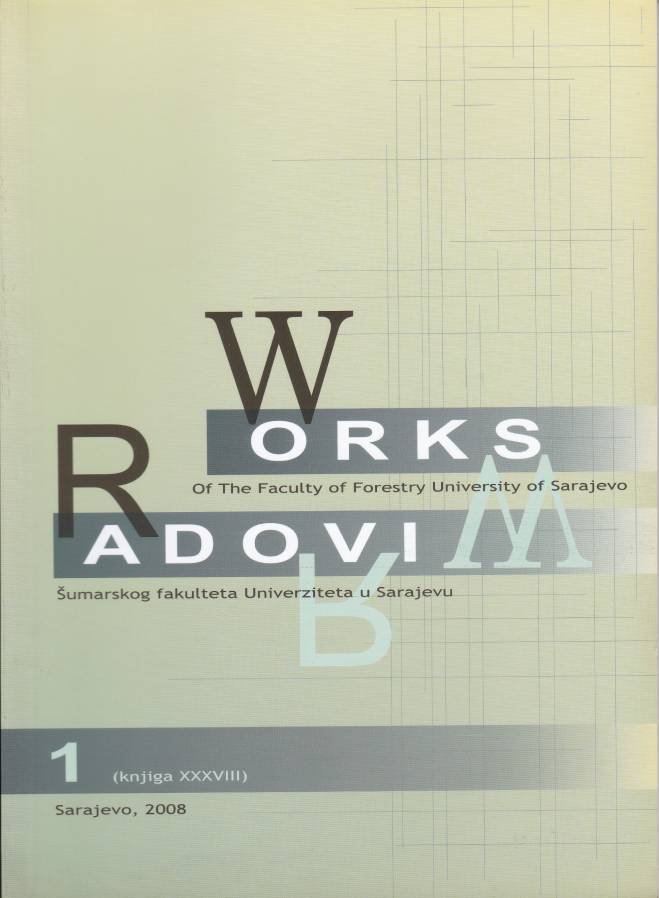Brown bear (Ursus arctos L.) damages at forest stands in Central Bosnia Canton
DOI:
https://doi.org/10.54652/rsf.2008.v38.i1.175Keywords:
Brown bear, Ursus arctos, bark-stripping, damage, tree, Koprivnica, VlašićAbstract
UDK 639.111.7:630*45(497.6)
In collecting the data on the damage caused by bears at forest stands we used practical bear damage evidence forms. We measured the damage at all damaged trees in two regions of the Central Bosnia Canton: Koprivnica and Vlašić. In both regions we found a total of 209 damaged trees (113 Koprivnica, 76 Vlašić). The selected tree species for the damage estimate was very strict: almost exclusively fir trees in Koprivnica and only spruce trees in Vlašić. The mean breast diameter at damaged fir trees is 40,5 cm and at spruce it was 33,73 cm. The extent of the damage is very serious, especially at fir trees, almost 50% of the damaged fir trees has been damaged up to two thirds (2/3) of the tree girth or completely girdled. In the Vlašić spruce trees, one third (1/3) of the tree girth or 91% damage. The average length of damage at fir trees is 88,16 cm (20-200 cm) and at spruce it is 157 cm (40-330 cm). Most of the damaged trees are in the breast diameter class of 31-50 cm (158). Beside the simple bark stripping, teeth marks are also visible, especially at fir tree.
This damage recalls the problem that existed in the late eighties of the last century, and represents a problem in bear management. In previous times, the pellet food was used as a possible solution instead of animal carcass and meat. Bear density in those regions was over 7 animals per 1000 ha. Drastic regulation of bear numbers was approved and conducted in the early 90's. Possible cause for this kind of damage can be the density, stress, disturbance by humans (forestry, recreation, quarries, etc), and extinction of ants due to Agricultural faculty experiments or monotonous food with animal proteins.
We discussed possible measures and their application in practice:
- Management changes? – without feeding more damages to crops, orchards, bee- hives and livestock;
- Food ingredients changes? – vitamins, etc – expensive solution at the moment;
- Optimal harvesting of population/regulation of bear numbers – lack of market (CITES);
- Adjust time and reduce harvesting in Forestry in Bear reserves? – extremely inconvenient solution for Forest enterprises;
- Detail research? – yes, but supported by state institutions;
References
CAUGHLEY G., SINCLAIR A.R.E.,: "Wildlife Ecology and Management", Blackwell Science, Cambridge, 1994.
Grupa autora: Studija "Ugrožene vrste divljači u Bosni i Hercegovini", MAGA&WALD Projekt, Banja Luka 2007.
HUBER, D. I MORIĆ, S. 1989. Štete od mrkih medvjeda u Jugoslaviji. Suvremeni pravci uzgoja divljači, Brioni. 3: 197-202.
Kunovac S., HADŽIĆ I., HELJA A., LIČANIN S. I NIKICA MARELJA: „Štete od medvjeda mrkog na šumskim sastojinama u BiH“, III Simpozijum o zaštiti bilja u BiH, Neum, decembar 2006.- prezentacija.
NADAŽDIN M.: „Prihranjivanje medvjeda“. Zbornik radova Simpozijuma: Savremeni aspekti gajenja, zaštite i korišćenja divljači u funkciji razvoja brdsko-planinskih područja Jugoslavije“, stenografske zabilješke: 207-208, Lovački Savez Jugoslavije, Požega 1996.
„Podzakonski akti Zakona o lovstvu FBiH”, Službene Novine FBiH, 02/08, 08/08,13/10. Sarajevo, 2008.
„Zakon o Lovstvu Federacije Bosne i Hercegovine”, Službene Novine FBiH, 04/06, Sarajevo, 2006.


















